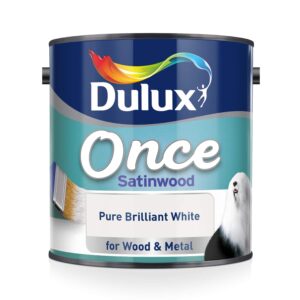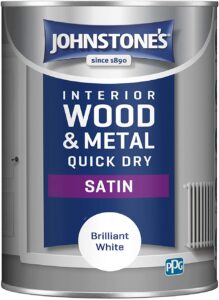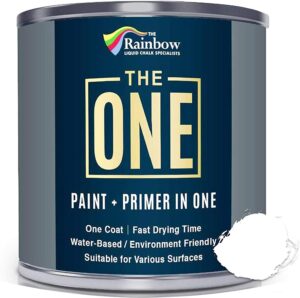
Whatever your aesthetic and design choices in your home, you want a paint that is going to complement and enhance what you’ve got. It’s important that you strike that balance with everything in the rest of the home, and ultimately, satinwood paint represents that balance pretty well. Satinwood, as a finish, sits midway between a flat matt look and a much shinier gloss, toning down the exuberance of gloss and putting a cheeky spin on matt. It’s also usually suitable for multiple different materials; most commonly wood and metal, but occasionally others.
This versatility makes it an ideal choice for all sorts of applications around the home. When you can paint almost any surface with one type of paint, suddenly the house becomes a blank canvas for your creativity (unless you rent, that is!) and you realise everywhere can be spruced up without the need for all different kinds of specialist paints.
Between all the different hues, brands and potential uses, knowing where to start can be a bit confusing. Lots of different companies produce satin paints, but they all offer slightly different variations. That’s what our summary of the best satinwood paints available on the market is for – read on for our best buys.
| Name | Coverage | Dry Time | Cost |
|---|---|---|---|
| Crown Quick Dry Satin | 12 m2 /l | 1 hours | £ |
| Dulux Once Satinwood | 12 m2 /l | 16 hours | ££ |
| Johnstone’s Quick Dry Interior Wood and Metal | 12 m2 /l | 2 hours | £ |
| Dulux Quick Dry Satinwood | 12 m2 /l | 6 hours | ££ |
| Rainbow The One Satin Finish | 12 m2 /l | 2 hours | ££ |
Crown Quick Dry Satin
Crown’s quick-drying Satin is a brilliantly versatile paint for both wood and metal surfaces. The colour is a true white once dried, and is resistant to yellowing to keep it looking fresh for longer. It can also be wiped clean with a damp cloth.
It’s also been formulated by Crown to be exceptionally low-odour thanks to their proprietary technology, which means the paint is solvent free. As it’s water-based it also dries very quickly, as the name gives away – it’s dry to the touch in around an hour, and needs 6 hours between coats should they be needed. It’s also very solid value for money, with a very respectable standard tin size of 2.5 litres giving you a lot more than what you pay for. It’s a great all rounder, especially for those in a hurry. As expected it is tough so great for areas which are heavily used such as skirting boards, bannisters and doors.
Pros
- Great finish
- Good value
- Quick drying
- Low odour
Cons
- A little thick
Dulux Once Satinwood
This satinwood option from Dulux is for those of us who hate doing several coats of paint. Is there anyone that does?! This paint doesn’t even require an undercoat (you’ll still need to make sure the surface is clean). Simply apply in one coat and if it doesn’t cover Dulux even provide a guarantee on this claim.
The only downside is it has a very long drying time, up to 16 hours! This might be a problem for some but not others. If you can leave the space and don’t have pets or children that might want to touch it you should be ok. Though even with other paints that require multiple coats, you’ll still be needing to keep the area for a long period of time. It can be used inside or outside and still as a decent coverage of 12 m2/l. This is a great option from Dulux.
Pros
- One coat
- No undercoat needed
- White long lasting
Cons
- Higher cost
Johnstone’s Quick Dry Interior Wood and Metal
Johnstone’s interior-specific satin paint is offered in a selection of 10 different hues that can be applied to both wood and metal. The colours range from lights to darks via creams and pinks, making it suitable for so many different aesthetics and areas in the house. The satin finish, between matt and gloss, is bold and hard-wearing meaning the colour pop you choose will stay that way for longer.
As a water-based paint, this is usually touch dry in around 2 hours. The water base also helps to keep the paint very low-odour, as well as making it pretty straightforward to wipe clean. This naturally means that your painting projects will stay looking fresh and bright for even longer, maximising the time between refresher coats of paint. Johnstone’s also offer their paint in larger containers which are excellent value for money.
Pros
- Great value
- Quick to dry
- Low odour
- Good colour selection
Cons
- A little thin
Dulux Quick Dry Satinwood
Dulux aims to make household painting a hassle-free experience with their range of quick-drying satin paint. Drying to a beautiful mid sheen, which sits between matt and glossy finshes, it’ll bring bright and bold colour to almost anything around the house – this is down to its versatile application to both wood and metal.
The paint is touch dry in just one hour and fully dry in 6 thanks to a water-based formula. You might need a couple of coats but with low odour levels paired with the short drying times this is very easy to work with, plus you it doesn’t require an undercoat which is a bonus. On top of that it’s non-drip for even greater ease of use, and is exceptionally durable to keep the beautiful white finish free from yellowing for longer. It’s also pretty solid value, with a good balance of quality and volume for the price.
Pros
- Quick to dry
- Excellent finish
- Durable
- Easy to use
Cons
- Limited colour options
Rainbow The One Satin Finish
The One from Rainbow Paints is, as the name suggests, a versatile choice that seeks to take some of the faff and hassle out of choosing a paint. Representing a solid choice for an all-round decorating solution, the combination of paint and primer in one takes extra steps out of the preparatory stages of decoration. The One also refers to the fact that one coat is all that should be needed.
Rainbow offer 11 different colour options for this satin finish paint, which offer bold yet subtle hues with a gorgeous mid-sheen finish when dry. Drying takes only a couple of hours, so in the unlikely event that a second coat is needed, you won’t be waiting long. It’s also suitable for a wide variety of surfaces including, but not limited to, wood, laminate, metal, brick and glass. As a water-based paint, it’s also very low in VOCs (Volatile Organic Compounds) and therefore has a very low odour. All told, a versatile and easy to use paint.
Pros
- Lots of colours
- Quick to dry
- Paint and primer combo
- Versatile use
Cons
- A little pricey
Which Satinwood Paint To Go For?
At the mid point between more muted matt tones and brighter glossy finishes, the almost silky finish of satinwood paint is sleek and stylish. It’s something that would be at home amongst a lot of household aesthetics, whether you’re going for a more rustic look or something on the modernist end of the spectrum. Regardless, there’s a lot out there to choose from and it can be a bit confusing. Here’s our summary of the best choice, as well as the best value choice, from our selection.
Best Satinwood Paint – Go with the Rainbow The One Satin Finish for a versatile and sound satin finish paint. You want colours? One paint for lots of different surfaces? Something that doesn’t need multiple layers and dries quickly? It checks all of those boxes and a few more for good measure.
Best Value – Johnstone’s Quick Dry Interior Wood and Metal stands out as the best option for value. It strikes a perfect balance between high-quality paint, with a quantity that will last multiple projects, with a very low initial investment. You get a lot for your money with this choice.
Satinwood Paint FAQ
How to apply Satinwood paint
As you would with any paint project, the item to be painted needs to be thoroughly cleaned. Sanding may also be a necessary step for things like wood. Once the surface is clean and ready, apply a primer coat (if needed – always check the label) and paint carefully with long, slow strokes using a brush or roller. You might need a couple of coats, so make sure to leave the requisite gap between applications.
What is satinwood paint?
Satinwood paint is a variety that dries to a mid-sheen finish. It tends to be hard-wearing when dry, either solvent- or water-based (the latter tends to produce less odour) and is most often versatile enough to be used on wood and metal, but sometimes other surfaces too.
How to put satinwood over gloss
Gloss is a common choice, especially in older houses, for things like skirting, architrave, door frames etc. You might take the decision to quieten down the, well, glossiness, and so painting over the existing gloss is something that you can do to ease the workload. However, you just need to make sure it’s properly prepared first. You may need to sand the surface down first to prepare it and even it out, but usually as long as gloss has been thoroughly cleaned with sugar soap and then primed, you will then be free to paint over it.
How long does satinwood paint take to dry?
Drying time will always vary by manufacturer, as well as conditions such as ventilation and temperature where you’re painting. However, for the most part satin is a fairly quick-drying option, with many brands being touch-dry in a couple of hours. Always check the label to be completely sure, and always err on the side of caution by allowing it slightly longer than you think it needs.
How to get satinwood paint out of carpets
This depends on the base of the paint. If it’s water- or solvent-based, warm water and a small amount of washing-up liquid with some gentle scrubbing will usually do the trick. In the case that it’s an oil-based paint, or for the most stubborn stains regardless of base, a steamer may be necessary to loosen the paint before carefully scraping it away. These are solutions for when the paint has dried, however, so try to catch it when the paint is still wet for a much easier time wiping it up.
How to clean satinwood paint off brushes
This partially depends on the base of the paint you’re using. If it’s a water-based paint, warm water will usually do the trick; if it’s a solvent-based paint, then you need a solvent-based paint cleaner. Either way, just soak your brushes up to the base of the bristles for around 2 hours, working the bristles against the side of the container to shift any stubborn residue. Also be sure to dry your brushes thoroughly afterwards.





